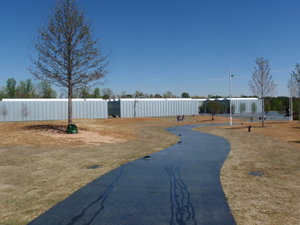Advertisement
Published: January 22nd 2012

 North Carolina Art Museum, west building
North Carolina Art Museum, west building
The newer of the two buildings, a high tech marvelNorth Carolina Museum of Art
I spent today in only one site, but it is a very important one:
The North Carolina Museum of Art.
This museum is very unusual in that it is owned and run by the state.
It may be the only state art museum on this scale in the US.
The museum currently covers two buildings.
The older one is an international style brick box built in the 1960s.
It reminded me of a well decorated office building.
The much newer building is a
high tech warehouse.
There are very few permanent interior walls.
The ceiling is covered with oddly shaped skylights that light the galleries naturally.
All of the walls are white.
It reminded me quite a bit of Dia Beacon (see
A Whole Lot About Nothing).
The museum
collection is encyclopedic, covering everything from
Egyptian mummies to
contemporary art from North Carolina.
It had more
academic French art than usual, and less Impressionism (in many museums, Impressionism takes up entire rooms).
The early
American art section has the usual portraits by the usual names (Copley, Stewart, etc.) but the pictures are of North Carolina residents.
I never knew they worked this far south.
The
modern art section

 North Carolina Museum of Art, east building
North Carolina Museum of Art, east building
North Carolina Museum of Art, east building. It looks like a nicely decorated office buildingwas pretty extensive for an encyclopedic museum.
The most impressive work was a photo by
Vik Muniz that at first glance looks like a drawn copy of an Old Master painting.
Only when one gets close does it resolve into individual pieces of junk carefully arranged to reproduce the wanted effect.
Exceptional, painstaking work.
Another painting by Argentinean artist
Guillermo Kuitca consisted of a wall of names connected to each other on a blood red background.
Many of the places for names are blank.
It memorializes the people
secretly abducted by the military during their dictatorship in the early 1980s.
The atrium of the older building is filled with little sculptures of butterflies hanging from the ceiling.
See them from a distance, and they resolve into the profile of a jet fighter in flight.
The piece is called Rabble, by Ralph Helmick and Stuart Schecter.
Finally, the entrance to the section contains a huge wall sculpture that looks vaguely like a large
African cloth, Lines that Link Humanity.
Closer inspection shows that the cloth is really composed of thousands of pieces of metal liquor packages.
It’s by renowned African modern artist
El Anatsui, and a

 Rodin's The Thinker
Rodin's The Thinker
Copy of The Thinker in the North Carolina Art Museum sculpture park.pointed critique of Ghanan history.
The cloth is patterned after traditional tribal weaving.
The liquor packages reference the fact that slave traders often used liquor as payment.
I had lunch at one of Raleigh’s better restaurants.
Its location is a bit surprising.
Iris at NCMA is a place that people deliberately go to eat, even if they are not seeing a museum show.
The art museum hired one of the area’s better chefs.
The food is southern classics with a modern twist.
There are lots of sandwiches with exotic toppings.
Somehow, it works.
30 Americans Show
After lunch came the real highlight of the day, a temporary show called
30 Americans, which had contemporary work from African American artists.
Somewhat ironically, the work had been assembled by a private collector instead of a museum,
Don Rubell (older brother of Steve from
Studio 54) in Miami.
The work is organized thematically.
First up is an older artist who expressed a particular idea.
Then there are younger artists who use similar ideas in different ways.
The show has two main, and contradictory, themes.
The first is

 Askew by Roxy Paine
Askew by Roxy Paine
Artificial tree in the sculpture gardenthat the ideas and techniques of these artists vary just as much as in art by artists with other backgrounds, so pigeonholing them based on skin color is a big disservice.
The other idea is that being part of a historic minority group is an indelible part of their experience, and this always shows in the art somehow.
A surprising amount of the work had political overtones.
Some of it was quite explicit.
One very famous work is a digitally altered photo by
Hank Willis Thomas, of a basketball player from behind with the Nike logo branded on his head.
A more subtle piece is based on the word paintings of Richard Hamilton, only in this case the quotes are taken from Richard Prior comedy routines about the state of the Black community.
Yet another piece was a large stack of cotton bales, to form an oppressive wall.
On a lighter note, there were several paintings by
Kehinde Wiley that replicate famous works from European art history, only with hip hop followers in place of the usual princes and kings.
For me, this show was a highlight of the trip so far.
Advertisement
Tot: 0.344s; Tpl: 0.023s; cc: 30; qc: 122; dbt: 0.2s; 1; m:domysql w:travelblog (10.17.0.13); sld: 1;
; mem: 1.4mb







